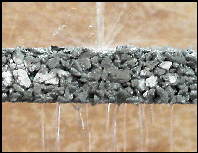Why Pervious?

1) To meet federal and local clean water regulations.
The U. S. Environmental Protection Agency Phase II regulations require owners of newly developed (or redeveloped) sites of 1 acre or more to have an on-site management system or treating storm water. The EPA has recognized pervious concrete as a Best Management Practice (BMP) for meeting its requirements.
2) To reduce costs.
Although pervious concrete pavement may be more expensive than typical concrete pavement, the project cost can be offset by reducing or eliminating the need for drainage systems and retention ponds and their associated construction and maintenance costs. Other project cost savings include:
• Reduced Grading. With no storm drains there is no need to slope the parking area. Pervious Concrete accepts the existing topography of the area.
• No storm sewer tie-ins. Eliminating the cost of underground piping and drain inverts can be a substantial savings.
• No additional stormwater pollution prevention devices. For example, sewer invert filtration
systems are unnecessary. Costs savings here are both up front and long term.
3) To gain green-building LEED credits.
Using pervious concrete can be part of a strategy that helps a project meet sustainability goals and gain valuable LEED credits. Possible contributions include:
• Stormwater Management. Pervious paving reduces stormwater flow and pollutant loads. Can contribute to LEED Credit 6.
• Heat Island Effect. The light colored surface can increase reflectivity and reduce heat build up. May contribute to LEED Credit SS 7.
• Minimize Site Disturbance. By integrating paving and drainage, less site area may need to be used, allowing a more compact site development footprint. May contribute to LEED Credit SS 5.
• Recycled content. Fly ash, slag cement, or silica fume can substitute partially for cement, and recycled aggregates can replace new gravel in the subgrade. Recycled content may contribute to LEED Credit M 4.
4) Profitable Ecology
Pervious concrete can also help to increase profitability while providing environmental benefits. Traditional stormwater management systems can take up 10 to 20 percent of the overall site for retention sites and bio-swales. Pervious concrete can double as a parking facility and stormwater treatment system, so this valuable space can be used to increase the density of development. In addition, tree wells can be very small since pervious concrete provides air and water to the tree roots. This increases the amount of usable space for parking while encouraging tree growth
that cools the lot and improves the air quality. The durability of concrete lowers the overall lifecycle cost with an expected life span of 20-40 years.
